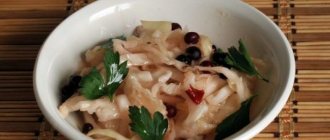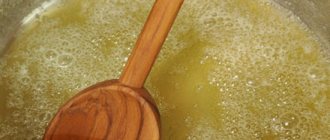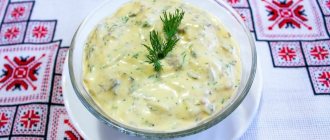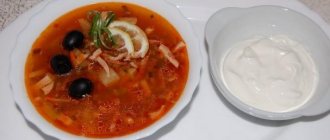Tkemali is a popular sauce in Georgian cuisine, the main ingredient of which is sour plum-tkemali, which is why the seasoning got its name. Ombalo (mint), which grows only in Georgia and Bulgaria, is used as a preservative, so you can get acquainted with the taste of the original product only at the place of production. It's hard to describe - hot-sweet-spicy, with sourness. The color depends on the degree of maturity of the raw materials: if the fruits are unripe, the seasoning will be green or brown, ripe ones will be pink, red or burgundy of varying saturation. Consistency - homogeneous, thick. The product is used to improve the taste of fish, meat and vegetable dishes, and pasta.
Taste characteristics
Many people know that the juicy shade of tkemali is due to the plum base. Sweet and sour plums are ideal for the sauce. They themselves are quite expressive, so no vinegar, lemon juice, or sweeteners are added to the sauce.
When thinking about what you eat tkemali with, consider not only taste characteristics, but also biochemistry. The tannins and pectin contained in plums help absorb and digest meat and fish. It significantly reduces the heaviness that sometimes occurs after a heavy dinner where fatty dishes were served. Of course, such food should not form the basis of the diet, but if on a holiday you decide to please your guests with baked chicken thighs or a pork belly roll, serve this sauce. It will not only make the taste harmonious, but also smooth out the effects of fatty foods.
Types of tkemali
Fans of gourmet cuisine will love the “Classic” tkemali - a sweet and sour sauce made from selected varieties of red tkemali plums.
Lovers of mild cuisine will love Tkemali “Tender” - a mildly spicy sauce with the aroma of yellow plums.
And the spicy “Shashlychny” will add piquancy not only to meat, but also to any lean dish.
Easy cooking method
If, preparing for a gala feast and knowing what tkemali sauce is eaten with, you decide to prepare it yourself, take care first of all of the necessary products. Ripe plums of sweet and sour varieties or slightly unripe sweet varieties are suitable. The presence of rotten plums is unacceptable; it will spoil not only the taste, but also the texture. To prepare the sauce you will need a kilogram of fruit. Rinse them under water, remove the tails and seeds. Place them in a saucepan, add a little water (about 0.5 tbsp.). Place on low heat and work on the rest of the ingredients.
The pepper pod should be finely chopped or crushed in a mortar. Pass garlic (4-5 cloves) through a crusher. You can simply chop half a bunch of cilantro finely with a knife.
If the skin of the plums begins to separate, then it’s time to move on to the next step. Grind the mixture through a fine sieve, using a ladle or pestle. Add the remaining ingredients to the mixture and boil again over low heat. To prevent the sauce from burning, stir with a spatula. You can serve this homemade sauce with many dishes.
Gooseberry tkemali
Tkemali is a very popular sauce not only in Georgia, but also abroad. It is so delicious that it is made not only from the plum of the same name. A similar sauce is also prepared from sour green gooseberries. The result is a thick, fragrant sauce that is in no way inferior in taste to the famous seasoning. Berries for tkemali must be selected from those varieties that remain sour even after ripening.
Components:
- gooseberries - 2 kg;
- granulated sugar - 3 tablespoons;
- salt - 1 tablespoon;
- garlic - 2 heads;
- coriander - 1 tablespoon;
- hot pepper - to taste;
- mint - a few leaves;
- cilantro - 1 bunch;
- dill - 1 bunch;
- salt.
Preparation:
- Wash the gooseberries, tear off the stems and petioles. Fill with water and put on fire. As soon as the gooseberries are cooked, they are rubbed through a sieve or crushed using a blender.
- Salt and granulated sugar can be put into the mass that has not yet cooled down.
- Coriander grains need to be crushed using a mortar and pestle or coffee grinder.
- Add chopped hot pepper there and grind. If you are not a fan of spicy foods, you can do without it. The main thing in this sauce is a lot of fragrant herbs and garlic, which is combined with the sourness of the berries.
- Garlic and leaves of cilantro, dill and mint need to be chopped in any convenient way. This is easy to do with a blender.
- Add herbs, garlic and spices to the cooled gooseberry puree. Salt and sugar can be added to taste.
- Prepare the jars in advance: sterilize and dry in the oven or microwave. Pour the sauce into jars and refrigerate, or in the refrigerator.
This sauce becomes tastier over time, so it is recommended to open it 1-2 months after preparation.
Pairing with meat and fish dishes
Do you know what plum tkemali is eaten with in Georgia? Of course, with lamb! For example, it is impossible to imagine chakapuli without it - a flavorful dish of young meat stewed in herbs and seasonings. In the Caucasus, this sauce is served with almost all meat dishes: kebab and shish kebab, fried chicken and chops.
You can take advantage of the experience of the creators of tkemali and boldly decide on any experiments. However, there are small restrictions. If the meat is prepared according to a complex recipe that already contains active flavors, tkemali may be completely inappropriate.
You should also be careful when serving dishes made from products that have their own interesting taste. For example, salmon and other types of noble red fish are not usually combined with rich seasonings, hot sauces, and garlic. Tkemali will simply outshine the exquisite delicacy. The success of combining this sauce with wild mushrooms is also controversial.
But tkemali can add a truly festive taste to ordinary boiled chicken or turkey, fried pork belly, smoked ribs and many other meat dishes.
What is tkemali plum sauce eaten with?
In Georgia, there are many variations in the preparation of tkemali, since the plum can be red, yellow and even green. Red sauce is boiled with the addition of yellow and red plums, but sloe is added to green sauce, making the taste of the sauce sweeter.
Since tkemali complements the taste of meat and fish dishes well, it is mainly served with them, first sprinkled with fresh chopped parsley and dill. Red sauce always accompanies kharcho. Yellow and green go perfectly with fried potatoes and pasta.
Tkemali in recipes
When thinking about what to eat tkemali sauce with, don’t be afraid to experiment. Often it is not served as a sauce on its own, but is added to other dishes during the cooking process. A couple of spoons of this product will add softness and piquancy to the kharcho if you replace tomato paste with it while preparing the frying. This sauce is used for dolma, stewed meat, meatballs, and chops. They do this not only to make the taste deeper and more expressive. The bright plum color of the sauce is easily transferred to other products stewed in it. The chicken turns out especially beautiful - the meat takes on a crimson hue.
Composition and calorie content of tkemali sauce
Despite the fact that the seasoning contains fruits, the nutritional value is quite high. The calculation is carried out relative to the classic recipe.
The calorie content of classic tkemali sauce is 64 kcal per 100 g, of which:
- Proteins - 0 g;
- Fats - 0 g;
- Carbohydrates - 16 g.
The composition of tkemali sauce is dominated by:
- Tocopherol - has an antioxidant effect, prevents the development of oncological processes.
- Niacin - provides the body with energy, accelerates the absorption of carbohydrates and proteins, and accelerates the regeneration of epithelial tissues.
- Retinol - without it, the production of steroid hormones and glycogen in muscles is impossible, improves the development of organic tissues.
- Ascorbic acid - participates in all metabolic processes of the body, without it normal life activity is impossible, improves the absorption of folic acid.
- Chlorine stimulates taste buds, increases appetite, and maintains a constant level of water and electrolyte balance.
- Phosphorus - ensures the growth of bone, cartilage tissue and pulp, participates in lipid-carbohydrate metabolism.
- Sulfur - improves the functioning of the nervous system and normalizes blood sugar levels.
- Pectins - remove heavy metals from the body.
- Tannins - protect the mucous membrane of the digestive organs from aggressive external influences.
Georgian seasoning can be included in the diet of those losing weight. It is impossible to eat a lot of the product because of its pungency, but a small amount speeds up metabolism and allows you to get rid of excess weight and regain the necessary slimness. This addition to the diet will help those losing weight get rid of the ever-present feeling of hunger and avoid the development of depression.
Preparation of marinades
Plums contain a lot of organic acids, which means the aromatic sauce can be used to pre-marinate products before heat treatment. Rub the pork pieces with tkemali sauce, add a little pomegranate juice or narsharab sauce and leave for several hours. By the way, if before a picnic you are trying to find interesting answers to the question of what tkemali is eaten with, be sure to take a jar with you into the wild. It goes perfectly with barbecue. But you can make a completely new sauce from the remaining marinade - simmer it until it boils, add fresh herbs and a little ketchup.
Come down from the mountains
Unfortunately, it is almost impossible to prepare traditional tkemali in a big city. Of course, Georgian cherry plum can be replaced with regular plum, and ombalo with mint or lemon balm. However, many useful and tasteful features of the sauce will be lost.
In this regard, a couple of years ago, even a whole movement of classic cuisine lovers appeared among culinary specialists. In search of ancient recipes and rare ingredients, they made expeditions to the Caucasus, prepared local sauces there, collected recipes, and then brought this delicious baggage home.
However, if you don’t have time for a full-fledged pilgrimage to the mountains, traditional tkemali can also be found ready-made. For more than 10 years, it has been producing ready-made Tkemali sauces under the KINTO brand. Unlike most ready-made dressings, they are prepared without artificial additives, preservatives or colorings. The unique production technology allows us to revive centuries-old traditions and recreate the classic taste of sauces, satisfying the whim of any gourmet.
Serving
It is important not only what tkemali is eaten with, but also how to serve it to the table. A gravy boat with a narrow spout or a cup with a spoon is suitable for these purposes. It is unacceptable to dip pieces of food into it; usually the sauce is added little by little to individual plates. At the most ceremonial receptions, each guest is served a small bowl, into which the sauce is either added immediately, or it must be added independently from a common sauce bowl.
Useful properties of tkemali sauce
This product is used not only for culinary but also for medicinal purposes. It can be used after various illnesses, given - albeit in small quantities - to small children and pregnant women.
Benefits of tkemali sauce:
- Helps quickly cope with vitamin deficiency, anemia, enhances the sense of taste and improves mood.
- Reduces the manifestation of painful symptoms during inflammatory processes of the gallbladder and urinary system.
- Normalizes blood pressure and reduces blood sugar levels.
- Accelerates peristalsis, stimulates intestinal metabolism, quickly removes waste and toxins from the body.
- Thanks to its antioxidant properties, it prevents the development of prostate and small intestine cancer and restores the function of sperm production.
- Reduces blood pressure.
- During infectious diseases, it lowers the temperature, helps to cope with complications - cough, bronchospasms, and restores breathing.
- Quickly normalizes general condition and helps cure vitamin deficiency.
- Useful for pregnant women and elderly people.
- Increases performance, improves memory function, speeds up reactions.
Thanks to rutin, which is part of the skin of blue plums, tkemali has a beneficial effect on the walls of blood vessels. They become more elastic, permeability decreases.











